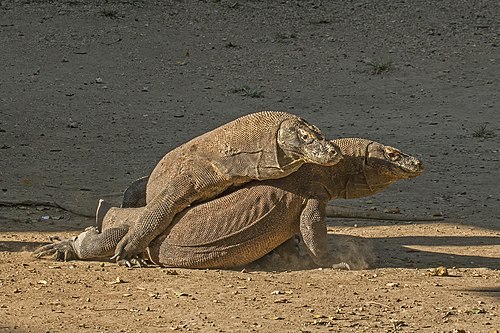| Revision as of 12:04, 1 June 2022 editAdam Cuerden (talk | contribs)Autopatrolled, Extended confirmed users, File movers, Pending changes reviewers52,550 edits File:Komodo dragons (Varanus komodoensis) fighting.jpg scheduled for POTD on 2022-10-13 (POTDHelper (sandbox))← Previous edit | Revision as of 01:54, 2 June 2022 edit undoLowercase sigmabot III (talk | contribs)Bots, Template editors2,311,060 editsm Archiving 2 discussion(s) to Talk:Komodo dragon/Archive 1) (botNext edit → | ||
| Line 57: | Line 57: | ||
| {{High traffic|date=5 March 2017|site=Google|url=https://www.google.com/webhp?hl=en&ictx=2&sa=X&ved=0ahUKEwjgkZrXkMHSAhUD92MKHf8RDpwQPQgD}} | {{High traffic|date=5 March 2017|site=Google|url=https://www.google.com/webhp?hl=en&ictx=2&sa=X&ved=0ahUKEwjgkZrXkMHSAhUD92MKHf8RDpwQPQgD}} | ||
| == parietal eye link == | |||
| Please add reference and link regarding presence of parietal eye. I would myself but the page is locked. ] (]) 02:36, 20 November 2021 (UTC) | |||
| == Semi-protected edit request on 20 January 2022 == | |||
| {{edit semi-protected|Komodo dragon|answered=yes}} | |||
| ] (]) 16:16, 20 January 2022 (UTC) I want to add more to tell more interesting things | |||
| :] '''Not done:''' it's not clear what changes you want to be made. Please mention the specific changes in a "change X to Y" format and provide a ] if appropriate.<!-- Template:ESp --> ] (]) 16:39, 20 January 2022 (UTC) | |||
| == Featured picture scheduled for POTD == | == Featured picture scheduled for POTD == | ||
Revision as of 01:54, 2 June 2022
| This is the talk page for discussing improvements to the Komodo dragon article. This is not a forum for general discussion of the article's subject. |
|
| Find sources: Google (books · news · scholar · free images · WP refs) · FENS · JSTOR · TWL |
| Archives: 1Auto-archiving period: 30 days |
| This article is written in British English, which has its own spelling conventions (colour, travelled, centre, defence, artefact, analyse) and some terms that are used in it may be different or absent from other varieties of English. According to the relevant style guide, this should not be changed without broad consensus. |
 | Komodo dragon is a featured article; it (or a previous version of it) has been identified as one of the best articles produced by the Misplaced Pages community. Even so, if you can update or improve it, please do so. | |||||||||||||||||||||||||||
| [REDACTED] | This article appeared on Misplaced Pages's Main Page as Today's featured article on November 7, 2008. | |||||||||||||||||||||||||||
| ||||||||||||||||||||||||||||
| This article has not yet been rated on Misplaced Pages's content assessment scale. It is of interest to the following WikiProjects: | |||||||||||||||||||||
Please add the quality rating to the {{WikiProject banner shell}} template instead of this project banner. See WP:PIQA for details.
{{WikiProject banner shell}} template instead of this project banner. See WP:PIQA for details.
| |||||||||||||||||||||
 | On 5 March 2017, Komodo dragon was linked from Google, a high-traffic website. (Traffic) All prior and subsequent edits to the article are noted in its revision history. |
Featured picture scheduled for POTD
Hello! This is to let editors know that File:Komodo dragons (Varanus komodoensis) fighting.jpg, a featured picture used in this article, has been selected as the English Misplaced Pages's picture of the day (POTD) for October 13, 2022. A preview of the POTD is displayed below and can be edited at Template:POTD/2022-10-13. For the greater benefit of readers, any potential improvements or maintenance that could benefit the quality of this article should be done before its scheduled appearance on the Main Page. If you have any concerns, please place a message at Misplaced Pages talk:Picture of the day. Thank you! Adam Cuerden Has about 7.9% of all FPs 12:04, 1 June 2022 (UTC)

|
|
The Komodo dragon (Varanus komodoensis), also known as the Komodo monitor, is a species of monitor lizard in the family Varanidae that is endemic to the Indonesian islands of Komodo, Rinca, Flores, and Gili Motang. It is the largest extant species of lizard, growing to a maximum length of 3 metres (10 ft), and weighing up to approximately 70 kilograms (150 lb). The Komodo dragon prefers hot and dry places, and typically lives in dry, open grassland, savanna, and tropical forest at low elevations. As an ectotherm, it is most active in the day, although it exhibits some nocturnal activity. Komodo dragons are solitary, coming together only to breed and eat. They are capable of running rapidly in brief sprints up to 20 km/h (12 mph), diving up to 4.5 metres (15 ft), and climbing trees proficiently when young through use of their strong claws. To catch out-of-reach prey, it may stand on its hind legs and use its tail as a support. As it matures, its claws are used primarily as weapons, as its great size makes climbing impractical. This photograph of two Komodo dragons fighting was taken on the island of Rinca, within Komodo National Park. Photograph credit: Charles J. Sharp Recently featured: |
- Misplaced Pages articles that use British English
- Misplaced Pages featured articles
- Featured articles that have appeared on the main page
- Featured articles that have appeared on the main page once
- Old requests for peer review
- All unassessed articles
- FA-Class Indonesia articles
- High-importance Indonesia articles
- WikiProject Indonesia articles
- FA-Class amphibian and reptile articles
- High-importance amphibian and reptile articles
- FA-Class amphibian and reptile articles of High-importance
- WikiProject Amphibians and Reptiles articles
- Articles linked from high traffic sites
